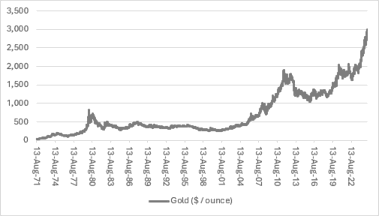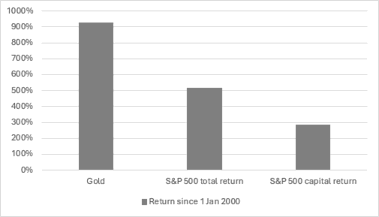
Gold has hit a new record high, surpassing the $3,000 an ounce mark early in April and reaching above $3,200 in the days following the tariff turmoil.
Central bank purchases of gold, plus substantial shipments into the US ahead of President Donald Trump’s imposition of tariffs helped to drive the price of gold upwards even before the tariffs put markets into turmoil, causing many to retreat to gold. Sticky inflation and ongoing concerns over lofty government debts on both sides of the Atlantic are also pushing some investors to gold.

Source: LSEG Refinitiv data
This looks like the third major bull run in gold since Richard M. Nixon withdrew America from the gold standard on 15 August 1971.
The first surge took place in the 1970s, after Nixon’s policy switch designed to free up room for US government spending, particularly in Vietnam. Two oil price shocks, in 1973 and 1979, stoked inflation and investors took fright from paper assets and promises, such as government debt, and sought out ‘real’ assets where supply only grew slowly instead.
The second took place in the early 2000s, as central banks played increasingly fast and easy with monetary policy in response to a series of crises. They ranged from the collapse of the LTCM hedge fund in 1998, the millennium IT bug, the collapse of the technology, media and telecoms bubble, and then the Global Financial Crisis and the European Debt Crisis. Record-low interest rates and quantitative easing followed, to persuade some investors that central banks and policymakers had lost control, just as it seemed they had in the 1970s.
The third, and current surge, has its origins in the past decade, as central banks continued to run zero-interest rate policies and did little to sterilise quantitative easing. Then came the Covid pandemic, and a crisis for which already-tattered government balance sheets were, in many cases, ill-prepared.
Government borrowing surged, especially in the UK and US, and in the latter the federal debt has continued to grow at an unprecedented pace. The result is that the annual interest bill is now $1.2 trillion, or more than a fifth of the federal tax take, a situation that seems unsustainable.
The Trump administration is trying to tackle this head on, with tariffs and efforts to boost America’s manufacturing base, but perhaps gold bugs are sensing another shift in global monetary policy and how the system is managed, especially as inflation remains stubbornly above central banks’ 2% target.
Whatever the reasons, each of these bull markets has been explosive.
| Gold price bull runs | ||||
| Start | Price | End | Price | Gain |
| Aug 1971 | $43 | Jan 1980 | $835 | 1,842% |
| July 1999 | $253 | Sep 2011 | $1,898 | 650% |
| Dec 2015 | $1,052 | Current | $2,993 | 185% |
Source: AJ Bell, LSEG
Gold bugs will argue there could still be more to come, given how the advance in this third bull phase still pales compared to the previous two.
They will also note how the metal has beaten the performance of the S&P 500 hands down since the year 2000, despite investors’ enthusiasm for equities, which leaves not just the S&P 500 but the Dow Jones Industrials and Nasdaq trading near to all-time highs after strong, post-Covid gains.

Source: AJ Bell, LSEG
Sceptics will point out the prior two runs both lasted for about a decade and how this one is almost 10 years old, too, if you take the December 2015 low as the starting point.
They may also take Warren Buffett’s line on the metal and assert its value can be no more than the cost of production, given its almost inert chemical nature, limited industrial use and inability to generate any cash or yield.
As such, gold may not be suitable for all investors. Those individuals who feel that gold offers some useful diversification in a balanced portfolio must still address the question of how best to approach the asset.
Should they feel that gold fits with their overall investment strategy, time horizon, target returns and appetite for risk, investors can glean exposure to the metal in a variety of different ways. They can do so directly, or through individual mining stocks or baskets of them, via actively or passively managed funds. Each approach comes with a different risk-reward profile that investors should consider if they decide to put some money behind the precious metal.
Four ways to invest in gold
1. Shares in gold mining companies
Some investors may want to think about gold miners, especially as the successful ones generate cash and pay a dividend, thus offering a yield. Their earnings and cash flow, and therefore potentially their dividends, are also highly geared to the gold price.
However, a series of takeovers leaves London-listed options thinner on the ground. There is only one gold mining stock in the FTSE 100, Endeavour Mining, while Fresnillo produces gold even if silver is its main commodity. Resolute Mining has a London listing, to accompany the one it has in Australia, and AIM offers a selection of around 20 gold miners of varying degrees of maturity, from mining licence-holders to prospectors and established producers.
The world’s biggest gold miners by stock market valuation are listed in the US. Not all gold miners are equal, and investors must patiently research them. This includes checking whether a gold miner is already producing or not, where the company operates, the cost of producing the gold, the expertise of the management and the miner’s balance sheet, among others.
2. Physical gold tracker fund
It’s possible to track the gold price through a tracker fund. The first option is to pick an exchange-traded commodity (ETC), or gold tracker fund, as investors may not wish to go to the trouble of storing and insuring their own gold bars or coins. It is possible to track the gold price in dollars or sterling and do so via the physical metal or futures prices, according to investors’ preference.
3. Gold miners’ tracker fund
For those who believe gold miners are cheap relative to gold – and who are prepared to take on the additional risk posed by miners’ operational gearing to the metal’s price – there is the option of a gold-related tracker fund. Such funds are designed to deliver the return generated by a basket of miners, minus the instrument’s own running costs.
4. Actively managed gold funds
Investors can access funds that invest in an actively managed portfolio of gold mining companies. Charges will typically be higher than a passive fund.
There are also a number of investment trusts on the UK stock market which dedicate themselves to gold (and silver, platinum and palladium) miners, while other more cautious multi-asset funds may have a large weighting toward gold bullion as part of their remit to protect and increase value per share for investors over the long term.
Ways to help you invest your money
Put your money to work with our range of investment accounts. Choose from ISAs, pensions, and more.
Let us give you a hand choosing investments. From managed funds to favourite picks, we’re here to help.
Our investment experts share their knowledge on how to keep your money working hard.
Related content
- Fri, 13/06/2025 - 10:47
- Fri, 13/06/2025 - 10:25
- Wed, 11/06/2025 - 09:38
- Fri, 06/06/2025 - 10:32

